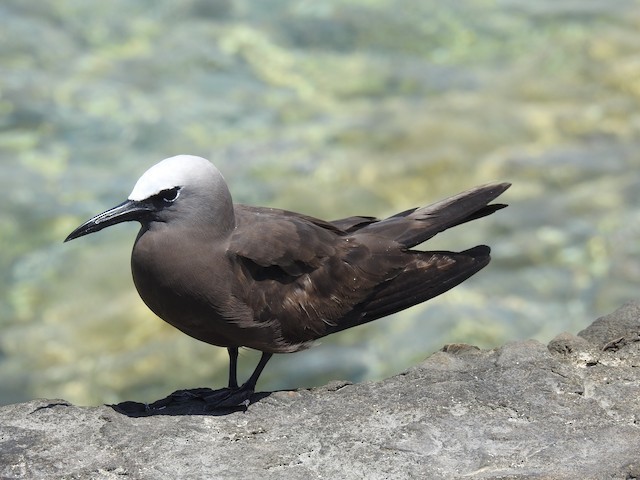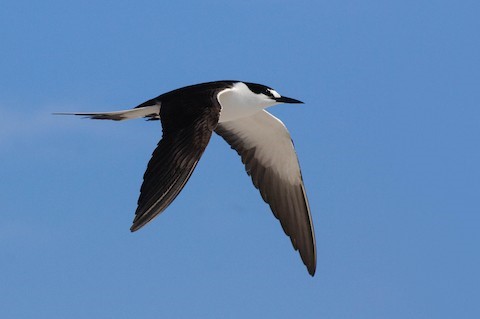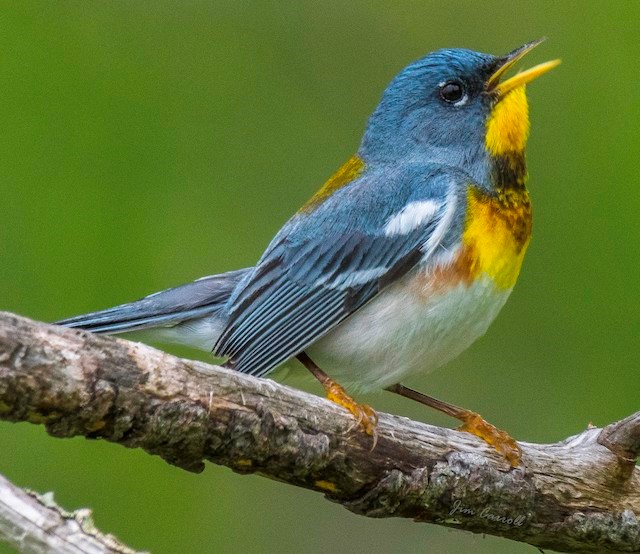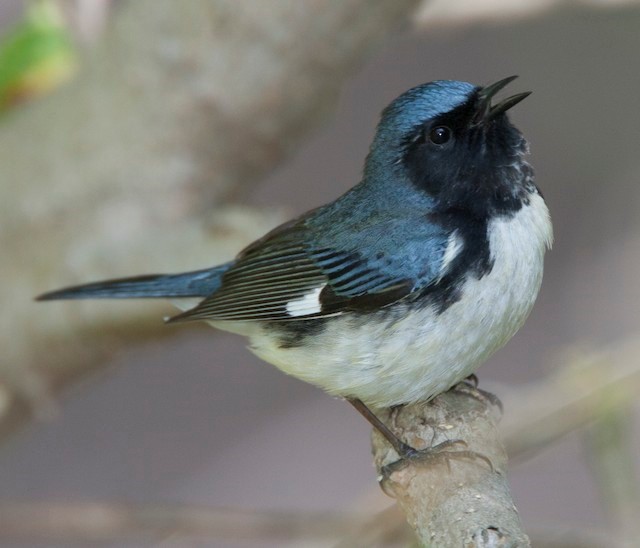Dry Tortugas National Park, Florida
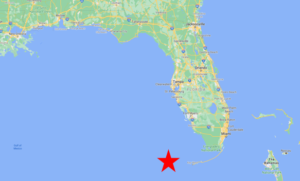
The Dry Tortugas are a cluster of tropical islands closer to Cuba than North America whose diverse charms include a monumental 19th Century fortress, coral reefs, clouds of seabirds, and an oasis of greenery for lost and tired songbirds. Sooty Terns and Brown Noddies nest in the thousands, Magnificent Frigatebirds and Masked Boobies in the dozens. Brown Booby, Black Noddy, and Bridled and Roseate Terns are regular nonbreeding visitors. In addition to migrants, the islands are strategically positioned to attract West Indian wanderers such as Red-footed Booby, “Antillean Short-eared Owl”, La Sagra’s Flycatcher, Bahama Mockingbird, Shiny Cowbird, and Yellow-faced Grassquit.
Orientation
Directions
The Dry Tortugas are a remote archipelago located about 70 miles west of Key West on the north side of the Straits of Florida at the entrance to the Gulf of Mexico.
Garden Key, the site of Fort Jefferson, is accessible by boat year-round from Key West on the Yankee Freedom III, which sails from the Key West Ferry Terminal at 100 Grinnell Street.
Take U.S. Highway 1 into Key West and remain on it until its junction with First Street and Palm Avenue. Turn right onto the Palm Avenue Causeway, which becomes Eaton Street.
At the third intersection, turn right onto Grinnell Street, follow it a block and a half to the parking garage on the left. The terminal is at the end of the next black. (Note that the Yankee Freedom ticket booth is a full block west of the terminal at 240 Margaret Street.)
Birdfinding
The Dry Tortugas in spring offer several prospects of interest to visiting birdwatchers. Most reliable are the nesting seabirds: Sooty Tern, Brown Noddy, Magnificent Frigatebird, and Masked Booby. Several other seabirds are usually present, including Brown Booby, Black Noddy, and eight more tern species.
Second, under certain weather patterns, the Tortugas are an exciting place to observe migrant songbirds, which are often exhausted and tame. In addition to the long-distance migrants, there are a few Floridian breeders near the edge of their ranges, principally Antillean Nighthawk, Gray Kingbird, and Black-whiskered Vireo.
Finally, as oceanic outposts on the edge of the Caribbean region, the Tortugas sometimes host rarities that wander north from the West Indies. These are always exceptional and unpredictable, but have included: Ruddy Quail-Dove, White-tipped Dove, Red-footed Booby (15+ records), “Antillean Short-eared Owl” (almost annual), La Sagra’s Flycatcher (twice), Piratic Flycatcher, Loggerhead Kingbird, Fork-tailed Flycatcher (five records), Bahama Mockingbird (seven records), Shiny Cowbird (almost annual), Red-legged Honeycreeper, and Yellow-faced Grassquit (three records). More are certain to follow.

The Magnificent Frigatebird is a constant presence overhead on Garden Key. © Maye Guifaro
Basic Planning. If you are considering a visit to the Dry Tortugas, the key decision is whether to take a day-trip from Key West or a multi-day camping trip. The default option is a day trip, which will give you about 4 and a half hours on Garden Key. This is long enough to see all the expected seabirds and whichever landbirds happen to be there on that day. A multi-day trip is a richer, more engaging experience—and there is a lot to see, even without leaving Garden Key—but it requires either a plan, a boat, or a tour operator.
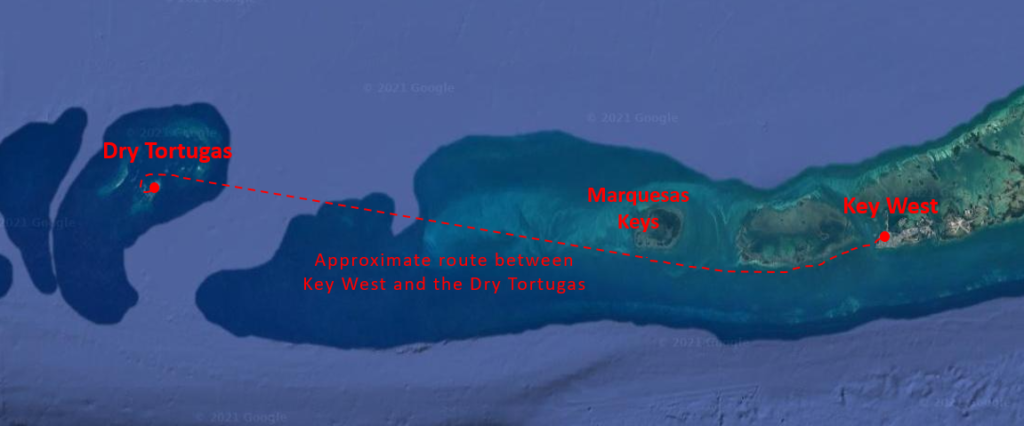
Ocean Transit. The ride from Key West to Fort Jefferson on a high-speed catamaran is fast and usually bumpy, which limits its potential for bird sightings. Most of the birds to be expected en route are the same coastal seabirds that are common in the Florida Keys.
The outer 30 miles or so passes through deeper water, which increases the likelihood of finding more strictly pelagic species. The most consistent tubenose is Audubon’s Shearwater. Also regular, but not guaranteed, are Wilson’s and Band-rumped Storm-Petrels and Cory’s Shearwater. Other pelagic species that have been seen rarely include Catesby’s and Red-billed Tropicbirds, Black-capped Petrel, and Great and Sooty Shearwaters.
Hospital Key. The route to Fort Jefferson passes fairly close to Hospital Key, a small sandy rise where about 30 pairs of Masked Booby nest. It is often possible to discern them as a distant cluster of white-and-dark specks. Depending on the circumstances, it may be worthwhile requesting that the captain make a closer and slower pass by the colony for a clearer view.
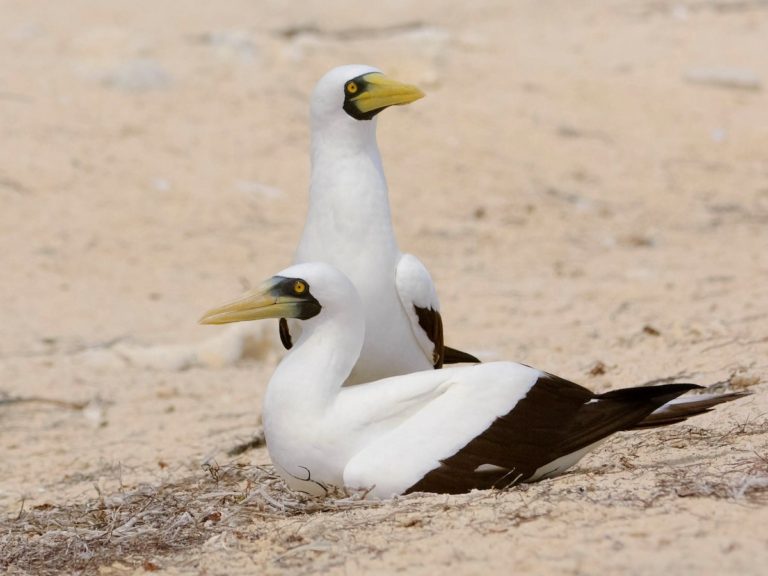
Masked Booby pair at Hospital Key. © Gerrit Vyn

Garden Key. Among the seven islands that comprise the Dry Tortugas, only one area is open to the public at all times—specifically, the eastern side of Garden Key (plus the adjoining seawall perimeter around Fort Jefferson). The main dock, where boat passengers arrive, is in the southern half of this public area. From this point, there are three directions one could walk: north, south, or across the bridge and into the fortress.
To the north is the northern coaling dock, usually the best place to observe seabirds, which congregate on the pilings and other structural remnants. In addition to swarms of Sooty Tern and Brown Noddy, this is the most likely place to find Black Noddy, Bridled Tern, and various other species.
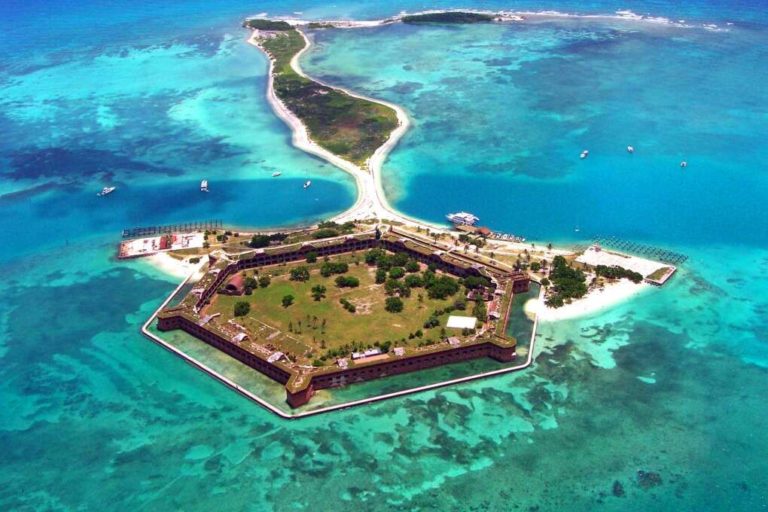
Garden, Bush, and Long Keys, viewed from the air. © Visit Florida

To the south are the southern coaling dock and the campground. There are fewer seabirds in this area, but the trees in the campground are often productive for migrant landbirds.
Fort Jefferson. Most of Garden Key is within the walls of Fort Jefferson, accessible through an entrance gate at the end of the bridge over the fort’s encircling moat. The gate is open, and the public may enter, between sunrise and sunset. The grounds of the fort have several trees, shrubs, garden plots, and other features that provide stopover habitat for the many migrant landbirds who avoid burial at sea by happening across the Dry Tortugas.
Bush and Long Keys. Immediately east of Garden Key is a perpendicular strip of land that is sometimes connected to it by an isthmus and sometimes separated by a shallow channel—and therefore a separate island. Historically, it must have been separate when the charts were drawn, because it is named as an island, Bush Key. At the eastern end of Bush Key another perpendicular strip of land extends to the south—sometimes separate, sometimes connected—called Long Key.
Bush Key is the largest seabird colony in the Dry Tortugas, with approximately 40,000 pairs of Sooty Tern and 2,000 pairs of Brown Noddy. Long Key is home to approximately 100 pairs of Magnificent Frigatebird and in some years also a few Brown Noddies. Most Dry Tortugas records of Red-footed Booby are individuals that take up residence for several months in which they regularly roost on the bushes on Bush or Long Key.
Long Key is closed to the public. Access to Bush Key is allowed only during a three-month period, from October 15 to January 15.
Loggerhead Key. For practical reasons, most visits to the Dry Tortugas are limited to Garden Key, the only island with regular boat service. The largest island in the archipelago is Loggerhead Key, three miles west, home to an operational lighthouse.
The island—but not the lighthouse—is open to the public during daylight hours, accessible via a dock on the east side. Much of the island is heavily vegetated and it receives its share of migrant landbirds. Overall, however, it tends to be less productive than Garden Key, possibly because the habitat is drier and denser.
Migrant Landbirds. Most of the migrant songbirds that occur on the Dry Tortugas winter in the West Indies or South America and funnel north through Florida, while a few others are “trans-Gulf migrants” which winter on the Yucatán Peninsula or in Central America and intentionally fly directly across the Gulf of Mexico.
Species that sometimes fall out in waves include Yellow-billed Cuckoo, Ruby-throated Hummingbird, Eastern Kingbird, Gray Catbird, Bobolink, Indigo Bunting, Dickcissel, and the following warblers: Ovenbird, Northern Waterthrush, Black-and-white, Common Yellowthroat, Hooded, American Redstart, Cape May, Northern Parula, Magnolia, Bay-breasted, Blackpoll, Black-throated Blue, Palm, Yellow-rumped, and Prairie.
Other migrants that occur regularly in smaller numbers include: Common Nighthawk, Chuck-will’s-widow, American Kestrel, Eastern Wood-Pewee, White-eyed and Red-eyed Vireos, Blue-gray Gnatcatcher, Veery, Gray-cheeked, Swainson’s, and Wood Thrushes, Orchard and Baltimore Orioles, Worm-eating, Prothonotary, Tennessee Warbler, American Yellow, Chestnut-sided, Yellow-throated, and Black-throated Green Warblers, Summer and Scarlet Tanagers, and Rose-breasted and Blue Grosbeaks. The bird-eating falcons, Merlin and Peregrine, are often present.
Services
Accommodations
On the Dry Tortugas. The southern end of Garden Key is a primitive campground with designated sites for tent-camping. Traditionally, the sites have been available on a first-come-first-served basis, and campers who arrive on the boat should walk directly to the campground and find a vacant or soon-to-be-vacant, numbered site. After identifying and informally claiming a site, you fill out a form and enclose the corresponding fee (cash only) to claim it formally.
In case there are no sites available, the grassy area east of the campground has traditionally been available for groups or overflow from the numbered sites. This policy is subject to change and should be confirmed both in preparation to travel (Dry Tortugas National Park, 1-305-242-7700) and upon arrival in the park office inside Fort Jefferson.
For advice on how to prepare, what to bring, and what to expect, see Dry Tortugas Camping Information.
In Key West. Boats depart early and traffic in the Keys is often paralyzed, so it is generally advisable to spend the pre-departure night somewhere near the dock. Key West has innumerable hotels and less formal accommodations.
Food
The general rule is to bring everything you expect to consume during your stay—including jugs of water for drinking and “bathing”—to the extent that this word applies in the Dry Tortugas. At times the park office has provided vending machines and a water fountain, but even these amenities are not guaranteed. Remember that the “dry” in Dry Tortugas refers to the absence of fresh water.
Transportation
The Public Option. Since the 1990s the “ferry” from Key West to Fort Jefferson has been a series of Yankee Freedom boats, originally from Gloucester, Massachusetts. The high-speed catamaran makes the 70-mile trip in a little over two hours, which is about as fast as a passenger boat can reasonably move through water. The service is popular and trip dates sell out many months in advance, especially during the seasons of peak demand. For current schedules, prices, and reservations, contact the Yankee Fleet, 1-800-634-0939.
Private Tours. Over the years various ecotourism companies, non-profit associations, and independent guides have offered tours to the Dry Tortugas, sometimes as a standalone and sometimes as the culmination of a larger South Florida tour. As of 2021, some of the current operators were: Eagle-Eye Tours, Victor Emanuel Nature Tours, Wildside Nature Tours, and WINGS.
Seaplane. Another option to consider, especially for those with more money than time, is to fly in from Key West for the day. Inquire with Key West Seaplane Adventures, 1-305-985-1124.
Notes
When to Visit
Spring is the favored season, especially April and early May. Species diversity, especially migrant landbirds, typically peaks around the last week of April.
It is generally preferable to avoid weekends, if possible. This can be important if you intend to camp, as campsites are most likely to be filled in advance on Fridays and Saturdays.
Links
10,000 Birds, Carlos Sanchez, The Dry Tortugas: A Must for Birders (March 7, 2013)
